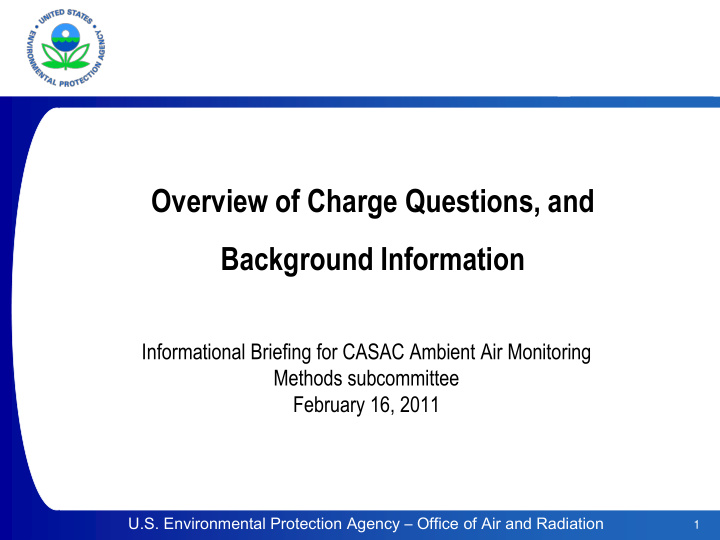



Overview of Charge Questions, and Background Information Informational Briefing for CASAC Ambient Air Monitoring Methods subcommittee February 16, 2011 U.S. Environmental Protection Agency – Office of Air and Radiation 1
Topics • Background • Overview of Charge Questions • ORD presentation of methods U.S. Environmental Protection Agency – Office of Air and Radiation 2
Some history………. Dear Dr. Hopke: Late 90’s This latter transmits primary source and background documents that will be the focus of the November 30, 1998 of PM 2.5 , speciation the Clean Air Scientific Advisory Committee (CASAC) Technical Subcommittee for Fine Particle Monitoring. Dear Ms. Whitman: Early 2000’s The Technical Subcommittee on Fine Particle Monitoring (hereafter, the "Subcommittee") of the Clean Air Scientific continuous PM 2.5 Advisory Committee (CASAC) held a public workshop at EPA's Environmental Research Center in Research (mass and speciation) Triangle Park, NC on Monday, January 22, 2001. The purpose of this workshop was to explore opportunities for accommodating emerging technologies into routine air monitoring networks. Dear Administrator Leavitt:The Clean Air Scientific Advisory Committee’s (CASAC) National Ambient Air Monitoring Strategy (NAAMS or Strategy”) Subcommittee (“Subcommittee”) met on July 8-9, 2003 to review the Agency’s ) National Ambient Air Monitoring Strategy document in a public meeting held at the EPA facility in Research Triangle Park, NC. This was the first CASAC related review of the draft NAAMS document. Members of the newly-formed Early 2000’s CASAC NAAMS Subcommittee National strategy The materials for information and review by the Ambient Air Monitoring and Methods (AAMM) Subcommittee of the Clean Air Scientific Advisory Committee (CASAC) are posted at the following URL: http://www.epa.gov/ttn/amtic/files/ambient/monitorstrat/section11.pdf. This material will be the subject of an advisory by the CASAC AAMM Subcommittee (Subcommittee) scheduled to be conducted in a public meeting scheduled for December 15, 2004, which 2005-2010 Individual NAAQS Today – near future Attached are materials for review by the Clean Air Scientific Advisory Committee’s (CASAC ) Air Monitoring and Near road, N/S, Methods Subcommittee (AMMS). These materials will be the subjects of an advisory meeting by the AMMS toxics. PAMS Subcommittee, scheduled to be held on February 16, 2011.
NOx/SOx plus • Beyond methodology issues • Broader issues of network design and leveraging observations, and models… U.S. Environmental Protection Agency – Office of Air and Radiation 4
NCore Measurements NCore Measurements Level 1. 3-10 Master Level 1. 3-10 Master Sites Comprehensive Sites Comprehensive Measurements, Measurements, Level 2: ~ 75 Multi- Level 2: ~ 75 Multi- Advance Methods Advance Methods pollutant (MP) pollutant (MP) Serving Science and Serving Science and Sites, “ Core Species ” Sites, “ Core Species ” Technology Transfer Technology Transfer Plus Leveraging From Plus Leveraging From L1 L1 Needs Needs PAMS, PAMS, Speciation Program, Speciation Program, L2 L2 L2 Air Toxics Air Toxics Level 3: Minimum Level 3: Minimum Single Pollutant Single Pollutant Sites (e.g.> 500 Sites (e.g.> 500 Level 3 Level 3 Level 3 sites each for O3 sites each for O3 and PM2.5 and and PM2.5 and related spatial related spatial Mapping Support Mapping Support Minimum “ Core ” Level 2 Measurements Minimum “ Core ” Level 2 Measurements Continuous NO,NOy,SO2,CO, PM2.5, Continuous NO,NOy,SO2,CO, PM2.5, PM10/PMc,O 3, Meteorology (T,RH,WS,WD) ; PM10/PMc,O 3, Meteorology (T,RH,WS,WD) ; Integrated PM2.5 FRM, HNO3, NH3, Integrated PM2.5 FRM, HNO3, NH3, U.S. Environmental Protection Agency – Office of Air and Radiation 5
NAS, CAAAC GEOSS CASAC, OMB NOAA EPA PM research NASA Eco-informatic CDC PHASE Test beds Organizations Private Sector NPS Programs AQ Risk/exposure forecasting assessments States/Tribes/RPO’s USDA Interstate orgs. Accountability/ NAAQS indicators setting DOE NARSTO Coordination Enviros SIPs, nat. rules Academia Cluster designations Mess NADP Satellite data Intensive studies IMPROVE, NCore PM monit, PAMS PM centers Supersites Data sources CASTNET Health/mort. records Other networks: SEARCH, IADN.. Lidar Emissions systems CMAQ Meteorology GEOS-CHEM
Materials • Att 1 – Monitoring paper – Previous chapter in PA dedicated to monitoring issues • Att 2 – chapter 2 of NOx/SOx PA on source emissions to water quality relevant to N/S (updated parts of Att 1) • Att 3 – near final CENRS/AQRS interagency monitoring report • Att 4 – White paper on rural networks and model support • Att 5 – ORD FRM development plan • Charge questions U.S. Environmental Protection Agency – Office of Air and Radiation 8
Overview of charge questions • Questions 1-4 – FRM considerations • Questions 5-8, 10 – non FRM valued measurements • Question 9, 11 • Network design U.S. Environmental Protection Agency – Office of Air and Radiation 9
Recommend
More recommend